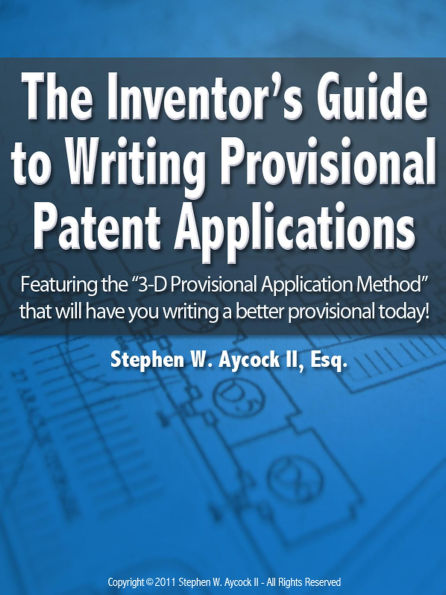The Guide contains the exclusive 3-D Method for provisional application writing, which shows you how to write a provisional in 3 easy steps. You will also learn how to shift from inventor-style thinking to patent attorney-style thinking and why this helps.
In the Guide you will learn:
- The purpose of a provisional application and how to make the most of it for your invention.
- The two parts required in a provisional patent application. If you leave one or both out, your application will not be effective.
- Two questions you must answer in your provisional application that help you meet the requirements.
- What to leave out (that many inventors include).
- How to find example provisional applications on file with the Patent Office for inventions in the same area of technology as your invention.
- Why you don't need to "write like a lawyer." And why doing so may hurt your application.
Reviews
"This book provides you everything you need to know for filing a provisional patent application.....all the information in the book is clear, concise, and direct. It allows the common person to take an idea and develop it in to an official provisional patent application without having to be a patent lawyer."
C.I., Maryland
The Guide contains the exclusive 3-D Method for provisional application writing, which shows you how to write a provisional in 3 easy steps. You will also learn how to shift from inventor-style thinking to patent attorney-style thinking and why this helps.
In the Guide you will learn:
- The purpose of a provisional application and how to make the most of it for your invention.
- The two parts required in a provisional patent application. If you leave one or both out, your application will not be effective.
- Two questions you must answer in your provisional application that help you meet the requirements.
- What to leave out (that many inventors include).
- How to find example provisional applications on file with the Patent Office for inventions in the same area of technology as your invention.
- Why you don't need to "write like a lawyer." And why doing so may hurt your application.
Reviews
"This book provides you everything you need to know for filing a provisional patent application.....all the information in the book is clear, concise, and direct. It allows the common person to take an idea and develop it in to an official provisional patent application without having to be a patent lawyer."
C.I., Maryland

The Inventor's Guide to Writing Provisional Patent Applications

The Inventor's Guide to Writing Provisional Patent Applications

Product Details
| BN ID: | 2940032870418 |
|---|---|
| Publisher: | Stephen Aycock |
| Publication date: | 10/26/2011 |
| Sold by: | Smashwords |
| Format: | eBook |
| File size: | 88 KB |
